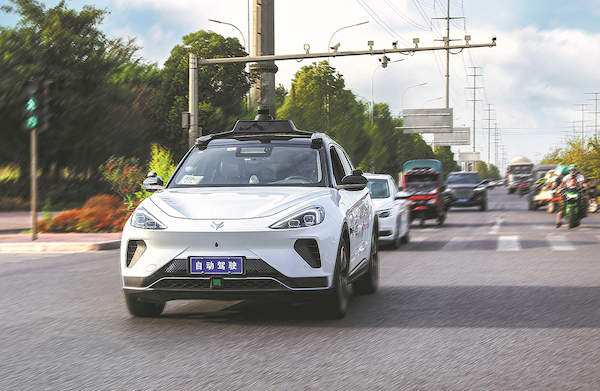
- Home
- Media Center
-
Events
- Wuzhen Summit
- Regional Forums
- Practice Cases of Jointly Building a Community with a Shared Future in Cyberspace
- World Internet Conference Awards for Pioneering Science and Technology
- The Light of Internet Expo
- Straight to Wuzhen Competition
- Global Youth Leadership Program
- WIC Distinguished Contribution Award
- Membership
- Research & Cooperation
- Digital Academy
-
Reports
- Collection of cases on Jointly Building a Community with a Shared Future in Cyberspace
- Collection of Shortlisted Achievements of World Internet Conference Awards for Pioneering Science and Technology
- Reports on Artificial Intelligence
- Reports on Cross—Border E—Commerce
- Reports on Data
- Outcomes of Think Tank Cooperation Program
- Series on Sovereignty in Cyberspace Theory and Practice
- Other Achievements
- About WIC
- 中文 | EN

Baidu shifts into high gear on robotaxis with world's top service area

A Baidu robotaxi runs on a street in Chongqing. CHINA DAILY
Chinese tech company Baidu Inc announced on Tuesday that it plans to scale up the operation area for its fully autonomous driving robotaxis and build the world's largest fully driverless ride-hailing service area in 2023, amid efforts to accelerate the commercialization of self-driving technology.
Baidu's self-developed artificial intelligence-powered second-generation Kunlun chip, which is designed to help devices process huge amounts of data and boost computing power, has completed an end-to-end performance adaptation for autonomous driving vehicles, the company said during Apollo Day, its self-driving tech event.
The move marks a major milestone in further solidifying and integrating Baidu's advantages in both autonomous driving software and hardware, said Ouyang Jian, CEO of Kunlun Chip.
The company has also unveiled its latest high-definition autonomous driving maps, which are equipped with several capabilities including automatic production and real-time updates, to safeguard a smarter and more efficient autonomous driving experience. The automation rate of Baidu's high precision map production has reached 96 percent.
China has rolled out a series of policies to promote the development and commercialization of self-driving technology. In August, Baidu secured the country's first permits to charge fares for fully driverless ride-hailing services — completely without human drivers in the car — in designated areas in Chongqing and Wuhan, capital of Hubei province.
Currently, the company's autonomous ride-hailing platform Apollo Go covers more than 10 cities in China, including Beijing, Shanghai and Guangdong province's Guangzhou and Shenzhen. In the third quarter, Apollo Go completed more than 474,000 rides, up 311 percent year-on-year, and a 65 percent increase compared with the second quarter.
"The high-definition autonomous driving map is an important prerequisite for bolstering the commercial use of self-driving vehicles, and needs the technical support from high-end chips boasting strong storage and computing capacities," said Zhang Xiang, visiting professor of the Engineering Department of Huanghe Science and Technology University.
The small-scale commercial operation of fully driverless robotaxis is expected to become a reality in 2025, considering the complicated traffic conditions, Zhang said, adding more efforts are needed to strengthen the construction of intelligent transportation infrastructure, such as 5G-enabled vehicle-road coordination systems.
Yang Diange, a professor from the School of Vehicle and Mobility at Tsinghua University, said, "Level 4 self-driving technology will first be deployed in taxis and trucks and in some designated areas, and large-scale application of such technology in private vehicles might be seen by 2030."
Level 4 autonomy means the car can drive by itself in most conditions without a human backup driver.
Yang said commercial operation of self-driving vehicles will promote the iteration and innovation of technologies, and help enterprises explore reasonable business models, thus allowing autonomous driving technologies to create more value.
As autonomous driving technology continues to mature, the sector is poised to witness robust growth in the coming years. The market size of China's self-driving taxi services is expected to surpass 1.3 trillion yuan ($181.5 billion) by 2030, accounting for 60 percent of the country's ride-hailing market by then, said a report by global consultancy IHS Markit.
According to BloombergNEF's 2022 electric vehicle outlook, China will operate the world's largest robotaxi fleet with about 12 million units by 2040, followed by the United States which is expected to operate around 7 million autonomous vehicles by then.

The World Internet Conference (WIC) was established as an international organization on July 12, 2022, headquartered in Beijing, China. It was jointly initiated by Global System for Mobile Communication Association (GSMA), National Computer Network Emergency Response Technical Team/Coordination Center of China (CNCERT), China Internet Network Information Center (CNNIC), Alibaba Group, Tencent, and Zhijiang Lab.





